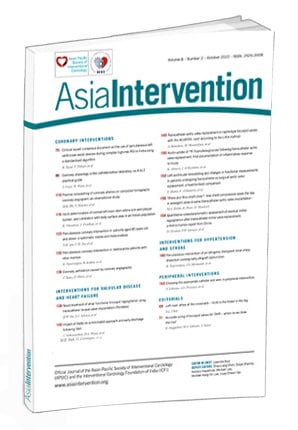At the time of writing this note several nice memories came to me. The EuroPCR meeting in Paris, where I was fortunate enough to participate again, the first time since 2019, was a bright part of the year. Seeing friends in the meeting was very exciting and educative. This year, AsiaIntervention had a combined meeting with the EuroIntervention editorial board, which acknowledged the efforts made by our journal. My take-home, however, was that our journal has a lot to learn from EuroIntervention’s phenomenal growth over the past 17 years. From 2023, AsiaIntervention will be increasing the frequency of its publications to 3 issues per year, with the ultimate goal of releasing a monthly issue. Reader interest is steadily improving and the number of high-quality submissions is steadily increasing.
This issue has a rich assortment of interesting reads on coronary artery interventions which have become widespread. Percutaneous coronary intervention (PCI) in present times has gone on to include high-risk patients with very poor left ventricular (LV) function needing LV support devices, especially Impella and ECMO. This needs a specialised unit, an algorithm and a Heart Team approach. A clinical expert review on high-risk PCI in India by Rajiv Tayal, Vijay Trehan and colleagues is available in this issue. This is followed by a review on coronary physiology in the cath lab. The importance of flow measurements, besides just looking at the angiographically determined stenotic areas, was initially recognised with the first balloon angioplasty performed by Andreas Gruntzig, who, in the first reported series in 1979, measured pressure gradients before and after procedures to define a successful operation. Utilising coronary physiology despite refinements in techniques and coupling it with computed tomography (CT) imaging and thus plaque morphology still has not been optimally utilised. This issue has all the details on “Coronary physiology in the catheterisation laboratory: an A to Z (practical) guide” by Simone Fezzi, William Wijns and colleagues.
Several other nuances of coronary artery disease have been detailed in this issue. These include an article by May Khei Hu, Vinoda Sharma and colleagues on the finding of positive remodelling on CT coronary angiograms as an adverse factor pointing towards the increased likelihood of adverse vascular events during follow-up in these patients. There is a general impression that South Asians have smaller coronary vessels and the well-known criteria for left main coronary artery (LMCA) stenting may not be appropriate for them. In this issue, Kirti Punamiya, Jasmine Pradhan and colleagues report a systematic intravascular ultrasound (IVUS)-based study carried out in 140 patients with an angiographically normal or a minimally diseased LMCA. The study demonstrated that in an Indian population the mean reference diameter and luminal diameter is not different from the LMCA of other ethnicities, and no different criteria are needed. Norman Huangyu Lin, Ching-Hui Sia and colleagues provide an interesting meta-analysis of more than 2.5 million patients of more than 80 years of age who had undergone PCI for all indications. It indicates that advanced age is an independent adverse risk factor including CV death, during follow-up to 3 years. PCI in patients with dextrocardia and situs inversus can be a challenge, especially in urgent situations like an acute coronary syndrome presentation. Rajesh Vijayvergia, Basant Kumar and colleagues have reported a series of 4 patients with this condition and have described useful technical tips to perform PCI in this group.
In the section on interventions for valvular heart disease, we have the first successful report from this region of treatment of severe tricuspid regurgitation with refractory heart failure using the TricValve from Quah Wy Jin, Shaiful Azmi Yahaya and colleagues. Sick patients needing TAVI often have an associated frailty adding to the problems of rehabilitation. In this issue, Janarthanan Sathananthan, David A. Wood and colleagues, using an acceptable frailty index, have demonstrated that a minimalist approach with early discharge can be used safely and get equivalent results to non-frail patients. Alessandro Beneduce, Matteo Montorfano and colleagues have addressed the issue of raphe type bicuspid aortic valve using a novel sizing method known as the LIRA technique using the new ACURATE neo2 successfully. Positron emission tomography (PET) imaging using 18F-fluorodeoxyglucose uptake done within 7 days of transcatheter aortic valve replacement (TAVR) can diagnose inflammation resulting from procedure related injury. It has been described by Khaled Almerri, Ibrahim Al Rashdan and colleagues, a phenomenon not reported earlier. It is thought that a successfully performed surgical aortic valve replacement (SAVR), as compared to TAVR, may have better LV remodelling and improved aortic valve area in real-world cases. This issue has been addressed by Yosef Manla, Firas Al Badarin and colleagues in a single-centre study. They report similar degree of benefit in haemodynamic and LV remodelling parameters.
The interventional flashlights in this section have a ghastly dissection of the conus branch of the right coronary artery (RCA), produced by a power injection of dye. Tetsuya Saito, Hiroshi Ohira and colleagues report this complication and educate us on “how not to do it”. Muthanna Abdul Halim, Karl Pool and Dale Murdoch has shown a valve-in-valve procedure during resuscitation with chest compression when it was not possible with the customary technique which resulted in a cardiac arrest. Rajesh Vijayvergiya, Yamasandi S. Shrimanth and colleagues, show a successful percutaneous intervention of an iatrogenic dissection of a renal artery in a case with allograft dysfunction, and Hesham Elzomor, Mao Chen, Yoshinobu Onuma and colleagues have reported a first-in-human case highlighting video densitometry as a feasible method to assess the degree of residual mitral regurgitation after a transcatheter method.
Finally, an expert review on the “how and why” of the hardware selection in peripheral interventions. “Choosing appropriate catheter and wire in peripheral intervention” by Sidhi Laksono, Ananta Siddhi Prawara and colleagues should be a good practical guide.
We leave you now with articles which will speak and amplify on all these aspects in this jumbo issue. Please do share your feedback.
